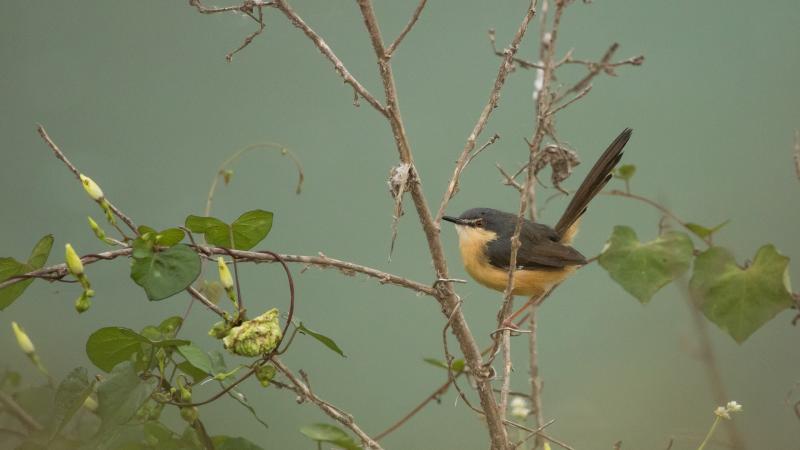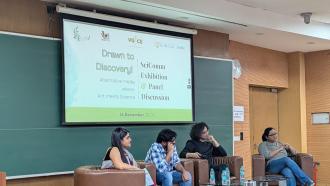
A chirp here, and a honk there! A twitter, a chirrup, a dog’s bark, a church’s bell and a bird song—all of these can come together in a city, and that’s why it is tough to be an urban bird. A call to a mate in this cacophony is nearly impossible to be heard. Hence, bird choruses everywhere, including in cities, use tactics like timing, perch, and the number of notes in their call to avoid overlaps. When migratory birds arrive, these tactics may become even more crucial to make themselves heard in a chorus.
In a recent study published in the Behavioral Ecology journal, Dr Anand Krishnan from the Indian Institute of Science Education and Research (IISER) Pune, studied birds’ singing activity and changes in the community structure of singing birds, before and after the arrival of migrant birds. The findings serve as a framework for monitoring rapidly-changing urban habitats through vocal birds and their singing behaviour.
Songs and calls serve diverse functions in organisms that tend to be more vocal, such as in whales, frogs, insects and birds. Birds have also evolved a variety of signals, which include calls to recognize others of their own species, signal threat, advertise territory and attract mates. These signals or vocalisations are known as acoustic signals. They are studied through a mathematical approach of the multidimensional signal space.
“The idea of acoustic signal space is that if we can represent a sound as a point in space, then the points from each species in a bird community should be in a different region of this signal space,” explains Dr Krishnan.
Each of these different regions is a unique ‘acoustic niche’. When each species is in a different region, the overall community is scattered or overdispersed across this space. The opposite scenario is clumping in which there are chances of song overlap.
Based on Dr Krishnan’s study of acoustic signal space, his students, Mr Shivam Chitnis and Ms Samyuktha Rajan, studied mating calls of four closely related species of Prinia. Competition and ecological factors cause birds to employ various strategies such as singing from different locations at different times of day, or between calls of other birds. These strategies are known as the partitioning of acoustic signal space. Their study is one of the few, that focus on the partitioning of acoustic signal space in birds occupying open habitats like scrub and grassland.
Both studies were conducted in an urban tropical scrub-grassland habitat inside the Vetal Tekdi Biodiversity Park—a public park in Pune, Maharashtra. The researchers recorded bird calls using microphones connected to a sound recorder. A unique aspect of these studies is that they are non-invasive, which means it does not involve the handling of birds and minimizes disturbance as much as possible.
In Dr Krishnan’s study, a total of 70 species were recorded in the winter, compared to the 56 species recorded during monsoon. The overall species diversity in the winter was higher than monsoon, and there was a change in the species composition. However, the number of birds recorded calling regularly, was relatively similar across seasons. Many birds that breed during monsoon were silent in winter, and some migrated out of the study area. These unoccupied acoustic niches, due to silence or movement of resident birds, could have been occupied by the migratory birds.
“The more important thing is not just that overdispersion is maintained, but that the overall pattern itself does not change,” emphasizes Dr Krishnan. “That suggests that the migrants are close relatives of some of the resident species and are fitting into the same signal space,” he adds.
Thus, despite the seasonal change in species composition, an overdispersed, stable acoustic community structure results in the monsoon and after the arrival of winter migrants.
Mr Chitnis’ work looks at the mating songs of closely related species.
“In the case of Prinias, the female risks accidentally mating with a male of a different species that sounds similar to her own species. Indeed, we found that closely-related Prinia partition their acoustic signal space and also the height from which they sing,” he says, about the findings.
The four Prinia species studied, sing from different acoustic niches to minimize overlap with each other. Additionally, they also produce various notes or repeat a single note at different rates to separate their calls from others of the same species. This difference in call notes is greater in their mating songs as compared to other calls. These birds employ different patterns of singing behaviour in response to various ecological factors as well as for effective sound transmission.
Like ecological pressures, birds respond to the changes in urban habitats due to land-use and developmental projects. Acoustic monitoring or studying bird sounds is a non-invasive method that can also be used to monitor urban ecosystems. For Dr Krishnan, it wasn’t easy to do in the hustle-bustle of the city!
“I picked up wind, rain, sirens, overflying aircraft, dogs barking, traffic from the city below, etc. In other parts of India, we regularly pick up Bollywood music!” he says. But with a trained ear, he has learnt to separate bird calls from the cacophony. “Still, life is much easier when the birds are vocal, and everything else is quiet, rare though that may be!”
Dr Krishnan and his group of researchers are now expanding passive acoustic and community acoustic studies to grassland and scrub habitats.
“We’re interested in exploring bird and bat acoustic communities of these poorly studied habitats. I think the method has great promise, and I’m keen to see what we can get out of it,” he signs off.
This article has been run past the researchers, whose work is covered, to ensure accuracy.






